| Grape Muscadine - Vitis rotundifolia | |||
|---|---|---|---|
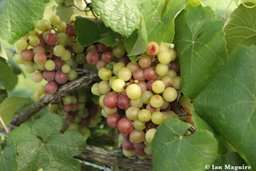 Fig. 1  Vitis rotundifolia  Fig. 2  Fig. 3  Granny Val is a large bronze grape recommended for fresh market 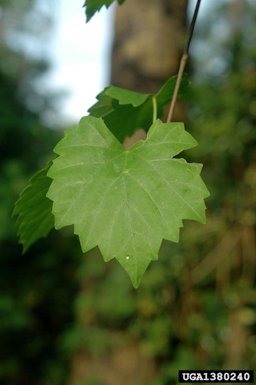 Fig. 4  Muscadine (V. rotundifolia) foliage 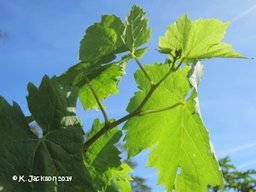 Fig. 5 Grape spring growth 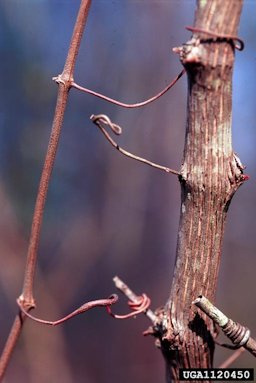 Fig. 6  Muscadine (V. rotundifolia) tendrils. 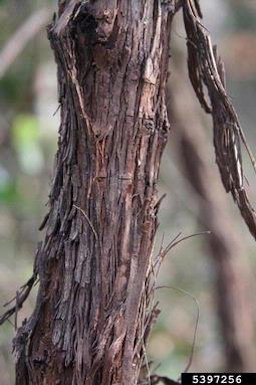 Fig. 7 Grape, V. sp. L. tree trunk 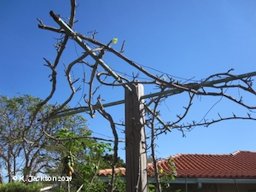 Fig. 8 Experimental support structure for home production 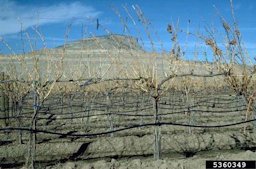 Fig. 9 Trellised grapevines in winter, Colorado 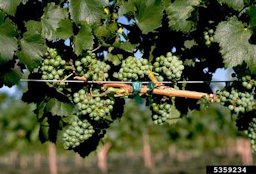 Fig. 10 Close-up view of the results of pruning and trellising 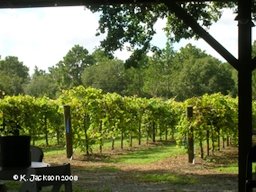 Fig. 11 Commercial trellis design Rosa Fiorelli Winery & Vineyard  Fig. 12 Grapes harvested and ready to process Rosa Fiorelli Winery & Vineyard 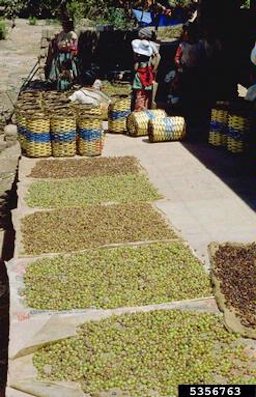 Fig. 13 Grape fruits spread out in the sun in Bolivia 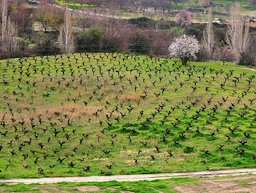 Fig. 14  Grape farm in Cyprus See also Bunch Grape Page |
Scientific
name Vitis rotundifolia Michx. Pronunciation VEE-tiss row-tun-dee-FOH-lee-ah Common names English: muscadine grape, southern fox grape; French: vigne musquée; German: Muscadinerebe; Spanish: moscada, vite moscata 7 Synonyms Muscadinia rotundifolia (Michx.) Small; M. munsoniana; M. rotundifolia var. munsoniana; Vitis munsoniana; V. rotundifolia var. munsoniana Relatives European grape, Vitis vinifera, summer grape, V. aestivalis widely distributed across the state; graybark grape, V. cinerea of the western panhandle; Florida grape, V. cinerea var. Floridana widespread through peninsular Florida; catbird grape, V. palmata of north Florida; Callosa grape, V. shuttleworthii of south and centra Florida and frost grape, V. vulpina of north Florida and west central Florida 8 Family Vitaceae Origin Native to Southeastern U.S.A. USDA hardiness zones Zones 6-10 Uses Eaten fresh, in juice, wine and jelly Height 8 ft (2.4 m) Spread Deciduous vines growing 60-100 ft (18-30.4 m) in the wild Plant habit Climbing vine Growth rate Slow then vigorous Trunk/bark/branches Woody vine with tendrils Pruning requirement Must be pruned to keep it manageable and to ensure maximum vine performance Leaves Slightly lobed; 2.5-5 in. (6.3-7.3 cm); rounded to broadly ovate with coarsely serrate edges; acuminate point Flowers Small, greenish flowers are borne in short, dense panicles; may be male, female or perfect Fruit Borne in small, loose clusters of 3-40 grapes on new growth; purple, round berries with tough skins; juicy, sweet, excellent flavor Season As early as late July for some cultivars and extends to late Sept. for others Crop Yield Well maintained vineyards can produce up to 15 tons of muscadines per acre 4 USDA Nutrient Content pdf Light requirement Full sun Soil tolerances Tolerates a wide range of soils but best results are obtained from well-drained sandy loams pH preference 5.5 to 6.5 Drought tolerance Regions with 30 in. (76 cm) of annual rainfall usually get enough rain to sustain the plants, unless summer dry spells stretch out past 60 days Soil salt tolerance Poor Cold tolerance Muscadine grapes seldom sustain frost injury in the spring due to the late bloom date. When acclimated, most vines can tolerate temperatures down to about 10 °F (-12 °C) without injury Plant spacing Planting distances and configurations are dependent on vineyard design 3 Pest resistance They are tolerant of most insect pests, and seldom are insecticides warranted Known hazard None Reading Material The Muscadine Grape, University of Florida pdf Home Garden Muscadines, University of Georgia, Cooperative Extension Production and Marketing Guide for Muscadine Grapes in Florida, Florida A&M University pdf Origin The muscadine grape is native to the southeastern United States, found in the wild from Delaware to the Gulf of Mexico and westward to Missouri, Kansas, Oklahoma, and Texas. Many older varieties were selections from the wild, but the Georgia Agricultural Experiment Station and the U.S. Dept. of Agriculture have introduced a number of improved varieties that have become standard cultivars. The earliest named variety was Scuppernong, found growing wild in northeastern North Caroline in 1810 by Dr. Calvin Jones. Scuppernong has become another name for all muscadine grapes. Commercial production of muscadine grapes is essentially limited to the U.S. Southeast. 2 America's First Grape: The Muscadine, USDA-ARS Small Fruit Research Station pdf Description Muscadines are vigorous, deciduous vines growing 60-100 ft. in the wild. Botanically, they differ in significant ways from other grapes and are placed in a separate sub-genus, Muscadinia. In contrast to most other grapes, muscadines have a tight, non-shedding bark, warty shoots and unbranched tendrils. 2 Botanical Diagram of the Grape Basic Grape Berry Structure, eXtension Foundation Stages of Grape Berry Development, eXtension Foundation Annual Cycle of the Grapevine, eXtension Foundation Parts of the Grape Vine Part I: Flowers and Fruit, eXtension Foundation Part II: Shoots, eXtension Foundation Part III: Roots, eXtension Foundation Flowers Muscadines are dioecious, with male and female flowers on different plants. The small, greenish flowers are borne in short, dense panicles. It appears that both wind and insects play a role in the pollination of the female flowers. 2 Flowers appear after several weeks of shoot growth, usually in April. 3 Leaves The slightly lobed, 2-1/2 to 5 inch leaves are rounded to broadly ovate with coarsely serrate edges and an acuminate point. Dark green above and green tinged yellow beneath, the leaves are glossy on both sides, becoming firm and subglabrous at maturity. 2 Fruit The fruit is borne in small, loose clusters of 3-40 grapes on the current year's growth, quite unlike the large, tight bunches characteristic of European and American grapes. The round, 1 to 1-1/2 inch fruits have a thick, tough skin and contain up to 5 hard, oblong seeds. In color the fruits range from greenish bronze through bronze, pinkish red, purple and almost black. Sugar content varies from about 16% to 25% for the sweetest cultivars. The wild fruits and some older cultivars have a musky quality similar to American grapes, although not as pronounced. Modern cultivars have a unique fruity flavor with very little muskiness. The flavor and appearance of the dark colored muscadine fruits are remarkably similar to the jaboticaba. 2 Varieties A cultivar good for fresh market consumption should be large, sweet, and attractive with a relatively thin skin. Yields should be consistently moderate to high and vine vigor and disease resistance should be satisfactory. A cultivar adapted for processing into wine, juice or jelly must produce consistently high yields. Berries should contain at least 14° Brix, should have a favorable sugar-acid ratio and should taste good. Berry ripening should be uniform so that multiple harvests are not required. Juice and wine grapes (particularly red-skinned grapes) must have a high degree of color stability. Berry appearance is not critical. 3 Muscadine Grape Varieties for Florida University of Georgia Muscadine Evaluation pdf Harvesting Harvesting can be accomplished by selecting individual grapes or bunches of grapes by hand, or by shaking berries loose from a vine into tarps positioned beneath the vine or by using mechanical harvesters that rake and shake the berries lose. Harvest is as early as late July for some cultivars and extends to late September for others. Typically, at least two harvests are required, but cultivars such as Fry or Welder may require up to 5 harvests. 3 Pollination Wild muscadine vines can be either male or female (dioecious) and must grow near each other in order for pollination to occur and grapes to form. If you don’t have the room for multiple vines, opt for a self-fertile variety, i.e. those that are said to have "perfect" flowers. Many varieties of muscadines are commercially available, and several of the most popular self-fertile cultivars in Florida are 'Carlos', 'Polyanna', 'Florida Fry', and 'Southern Home' (the latter is actually a hybrid of bunch and muscadine grapes developed in Florida). 1 Propagation The most common propagation method is to make 2- to 3-node-long cuttings from shoots 1/4 to 3/8 inches in diameter in June or July. Simply insert the basal end of the cutting in a light textured soil or potting media. Keep the roots and leaves moist until roots have formed (usually about 2 weeks). A mist bed can be inexpensively constructed for this purpose. The buds in the leaf axils will break and form shoots shortly thereafter. Another method to asexually propagate muscadine grapes is called pegging. To use this method, wound a low growing shoot by making successive cuts in the bark and then cover it with moist soil. Leave the shoot tip exposed. After about a month, roots should have formed, and the shoot may be severed from the mother vine. Pegging can be done in the summer months and is most useful to propagate a few vines. 3 Diagram for Grape Propagation, University of Florida, MREC/IFAS pdf Propagate Ornamentals and Muscadines, University of Florida, Okaloosa County pdf (archived) Propagation of Grape Vine Cuttings: A Practical Guide, New Mexico State University pdf Growing Bare-root vines should be planted December through February, whereas container-grown vines can be planted throughout the year provided that they receive adequate irrigation. The most critical elements to success of newly planted and young vines are irrigation and weed control. A hole should be dug to accommodate the entire root system, usually about 2 feet deep and 2 feet wide. 3 Growing Muscadine Grapes, Florida A&M University pdf Improving Size and Quality of Seedless Grapes, New Mexico State University pdf Pruning The best time to prune is mid-January to mid-March. After a grapevine has been trained to a desired configuration, it must be pruned to keep it manageable and to ensure maximum vine performance. Major pruning is normally done during the dormant season, although touch-up pruning can be done during the growing season. The standard rule is to allow 2 to 4 node spurs spaced about every 6 inches of cordon. 3 Pruning Grape Vines, eXtension Foundation Pruning Grapes to the Four-Arm Kniffin System, New Mexico State University pdf Pruning Muscadine Grapevines, University of Florida, MREC/IFAS pdf Prune Grape Vines for Maximum Yield, University of Florida pdf Training/Trellis The first year, set a 6.5-foot stake by each plant and tie the stake to the top wire of the trellis. As shoots begin to grow from the plant, select the healthiest shoot and secure it to the stake with string or tape. Remove all other shoots. As the selected shoot grows, it eventually becomes the trunk of the vine. It is important to keep it growing straight up the stake by (a) tying with string as needed for support and (b) removing lateral and base sprouts while they are small. Be sure to leave at least one lateral shoot to grow each way along each wire. 5 Vineyard Trellis Construction, University of Florida, MREC/IFAS pdf Vineyard Trellis Materials, University of Florida, MREC/IFAS pdf Muscadine Grape Trellis Systems, University of Georgia, Cooperative Extension Trellis End Post Assembly Designs for Vineyards, New Mexico State University pdf Fertilizing Apply the fertilizer in bands about 1 foot to either side of the vine. It is sometimes beneficial to apply fertilizer that has micronutrients added. Repeat this process in June and in August. During the second year, apply 1 to 2 lb of fertilizer per vine in March and again in June/July. In future years, the fertilization rates can be 3 to 4 lbs of fertilizer per vine during March and June/July. 1 Irrigation Irrigation is essential during the entire establishment year for muscadine grapes. Irrigation will also be beneficial for fruiting vines. The most critical period for irrigation is May through June. After this time, the quantity of summer rainfall is usually sufficient to meet the vine needs. 3 Pests One reason for the popularity of muscadine grapes is that they are a sustainable fruit crop in the southeastern United States. They are tolerant of insect and disease pests, and homeowners can successfully grow muscadine grapes without spraying any pesticides. 3 Pest Page Diseases The most common diseases on muscadine grape berries and/or leaves are angular leaf spot, black rot, ripe rot, macrophoma rot and powdery mildew. Bitter rot can infect all above ground tissue. 3 Diseases Page Food Uses Out of hand as they come off the vine. They can be made into jelly, jam, wine, raisins, fruit leather; the seeds can be pressed for oil and the young leaves boiled and eaten. The leaves of the hybrids are preferred to the muscadines. Muscadines can be high in acid so when crushing to make jelly don’t use your hand. Oh, and the seeds can be used to make grappa. 6 Freeze-Dried Muscadine Grape: a New Product for Health-Conscious Consumers and the Food Industry, University of Florida pdf Winemaking at Home, University of Georgia, Cooperative Extension pdf Medicinal Properties ** Immune Benefits of Consuming Red Muscadine Wine, University of Florida pdf (archived) Tidbits from D. Greene 1. If you make grape jelly from muscadines don’t crush them bare handed or bare footed. The high acid content can lightly burn your hands or feet. Also, grape sap is drinkable. 2. The grape vine, however, has a peculiar vascular arrangement. If you cut the vine it will not leak water unless you invert it. You can get a quart or more from a one-foot piece. 3. In all English dialects except American English “vine” means the grape vine. In American English “vine” can mean many plants, not just the grape vine. 6 Other Uses Muscadines are grown on trellises or arbors for their fruit or for the screening effect they produce when in leaf. 4
Fig. 15. Muscadine grape distribution map, wild populations Further Reading History of Grapes in Florida and Grape Pionneers, University of Florida pdf TimeLine: Grapes in Florida, University of Florida pdf United States Standards for Grades of Muscadine (Vitis rotundifolia) Grapes pdf Muscadine Grape, California Rare Fruit Growers Schedule for Grape Production Practices in Florida, University of Florida, MREC pdf (archived) Grapes of Path, Eat The Weeds Frequently Asked Questions, University of Florida, Nassau County Florida Grape Growers Association ext. link Grape Botanical Art List of Growers and Vendors |
||
| Bibliography 1 "Muscadine Grapes." Gardening Solutions, UF/IFAS, AsKIFAS, gardeningsolutions.ifas.ufl.edu. Accessed 7 Nov. 2014 2 "Muscadine Grape." California Rare Fruit Growers, 1997, crfg.org. Accessed 8 Nov. 2014. 3 Andersen, Peter C., et al. "The Muscadine Grape." Horticultural Sciences Dept., UF/IFAS Extension, Pub. June 2003, Revised Nov. 2010, Oct. 2013 and, Jan. 2017, Oct. 2020, Reviewed Sept. 2023, HS763, AskIFA, edis.ifas.ufl.edu/hs100. Accessed 15 Sept. 2018, 29 Sept. 2020, 27 Apr. 2024. 4 Christman, Steve. "Vitis rotundifolia." Floridata, 5 Oct. 2010, floridata.com. Accessed 8 Nov. 2014. 5 Andersen, P .C. "The Bunch Grape." Horticultural Sciences Department, UF/IFAS Extension, HS-17A, Original pub. Aug. 2001, Revised Apr. 2014, and May 2017, Reviewed June 2020, AsKIFAS, edis.ifas.ufl.edu/mg105. Accessed 17 Sept. 2018, 28 Sept. 2020. 6 Deane, Green. "Grapes of Path." Eat the Weeds and other things, too. www.eattheweeds.com. Accessed 19 July 2016. 7 "Vitis rotundifolia Michx." USDA, ARS, National Genetic Resources Program,Germplasm Resources Information Network - (GRIN) [Online Database], National Germplasm Resources Laboratory, ars-grin.gov. Accessed 15 Aug. 2016. 8 Boning, Charles R. Florida's Best Fruiting Plants- Native and Exotic Trees, Shrubs, and Vines. Pineapple Press, Sarasota, Florida, 2006. Photographs Fig. 1 Maguire, Ian. "Muscadine Grape." Gardening Solutions, UF/IFAS, AsKIFAS, gardeningsolutions.ifas.ufl.edu. Accessed 8 Nov. 2014. Fig. 2,5,8,11,12 Jackson, Karen. "Grape Series." 2008, www.growables.org. Fig. 3 Andersen, Peter C. "Granny Val is a large bronze grape recommended for fresh market." UF/IFAS Extension, AsKIFAS, edis.ifas.ufl.edu. Accessed 27 Aug. 2016. Fig. 4 Evans, Chris. "Vitis rotundifolia. Foliage." University of Illinois, 2010, Bugwood.org, (CC BY-NC 3.0 US), bugwood.org. Accessed 27 Aug. 2016. Fig. 6 Miller, James H. "Muscadine (Vitis rotundifolia) Michx. Tendrils." USDA Forest Service, 2011, Bugwood.org, (CC BY-NC 3.0 US), bugwood.org. Accessed 27 Aug. 2016. Fig. 7 Videki, Robert. "Grape, Vitis sp. L. tree trunk." Doronicum Kft, 2009, Bugwood.org, bugwood.org. Accessed 30 Nov. 2014. Fig. 9 Schwartz, Howard F. "Trellised grapevines in winter, Colorado." Colorado State University, 2008, Bugwood.org, bugwood.org. Accessed 29 Nov. 2014. Fig. 10 Schwartz, Howard F. "Close-up view of the results of pruning and trellising." Colorado State University, 2008, Bugwood.org, bugwood.org. Accessed 29 Nov. 2014. Fig. 13 Brown, William M. Jr. "Grape fruits spread out in the sun in Bolivia." Colorado State University, 2008, Bugwood.org, bugwood.org. Accessed 30 Nov. 2014. Fig. 14 Mamchenkov, Leonid. "Grape farm in Cyprus." Flickr, 2007, (CC BY 2.0), flickr.com. Accessed 27 Aug. 2016. Fig. 15 Wunderlin, R. P., et al. "Vitis rotundifolia. Species Distribution Map." Atlas of Florida Plants, [S. M. Landry and K. N. Campbell (application development), USF Water Institute.] Institute for Systematic Botany, University of South Florida, Tampa, 2016, florida.plantatlas.usf.edu./Plant.aspx?id=389. Accessed 15 Aug. 2016. ** Information provided is not intended to be used as a guide for treatment of medical conditions. Published 12 Apr. 2014 LR. Last update 27 Apr. 2024 LR |
|||